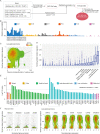From tobacco smoking to cancer mutational signature: a mediation analysis strategy to explore the role of epigenetic changes
- PMID: 32928150
- PMCID: PMC7488848
- DOI: 10.1186/s12885-020-07368-1
From tobacco smoking to cancer mutational signature: a mediation analysis strategy to explore the role of epigenetic changes
Abstract
Background: Tobacco smoking is associated with a unique mutational signature in the human cancer genome. It is unclear whether tobacco smoking-altered DNA methylations and gene expressions affect smoking-related mutational signature.
Methods: We systematically analyzed the smoking-related DNA methylation sites reported from five previous casecontrol studies in peripheral blood cells to identify possible target genes. Using the mediation analysis approach, we evaluated whether the association of tobacco smoking with mutational signature is mediated through altered DNA methylation and expression of these target genes in lung adenocarcinoma tumor tissues.
Results: Based on data obtained from 21,108 blood samples, we identified 374 smoking-related DNA methylation sites, annotated to 248 target genes. Using data from DNA methylations, gene expressions and smoking-related mutational signature generated from ~ 7700 tumor tissue samples across 26 cancer types from The Cancer Genome Atlas (TCGA), we found 11 of the 248 target genes whose expressions were associated with smoking-related mutational signature at a Bonferroni-correction P < 0.001. This included four for head and neck cancer, and seven for lung adenocarcinoma. In lung adenocarcinoma, our results showed that smoking increased the expression of three genes, AHRR, GPR15, and HDGF, and decreased the expression of two genes, CAPN8, and RPS6KA1, which were consequently associated with increased smoking-related mutational signature. Additional evidence showed that the elevated expression of AHRR and GPR15 were associated with smoking-altered hypomethylations at cg14817490 and cg19859270, respectively, in lung adenocarcinoma tumor tissues. Lastly, we showed that decreased expression of RPS6KA1, were associated with poor survival of lung cancer patients.
Conclusions: Our findings provide novel insight into the contributions of tobacco smoking to carcinogenesis through the underlying mechanisms of the elevated mutational signature by altered DNA methylations and gene expressions.
Keywords: Gene expression; Mediation analysis; Methylation; Mutational signature; Tobacco smoking.
Conflict of interest statement
We declare no competing interests.
Figures



Similar articles
-
Impact of mutations in DNA methylation modification genes on genome-wide methylation landscapes and downstream gene activations in pan-cancer.BMC Med Genomics. 2020 Feb 24;13(Suppl 3):27. doi: 10.1186/s12920-020-0659-4. BMC Med Genomics. 2020. PMID: 32093698 Free PMC article.
-
Tobacco smoking differently influences cell types of the innate and adaptive immune system-indications from CpG site methylation.Clin Epigenetics. 2016 Aug 3;7:83. doi: 10.1186/s13148-016-0249-7. eCollection 2015. Clin Epigenetics. 2016. PMID: 27493699 Free PMC article.
-
Tobacco Smoking-Associated Alterations in the Immune Microenvironment of Squamous Cell Carcinomas.J Natl Cancer Inst. 2018 Dec 1;110(12):1386-1392. doi: 10.1093/jnci/djy060. J Natl Cancer Inst. 2018. PMID: 29659925 Free PMC article.
-
Comparison of genome-wide analysis techniques to DNA methylation analysis in human cancer.J Cell Physiol. 2018 May;233(5):3968-3981. doi: 10.1002/jcp.26176. Epub 2017 Oct 4. J Cell Physiol. 2018. PMID: 28888056 Review.
-
À la recherche du temps perdu: Smoking and Genomic Imprinting.Mo Med. 2017 Sep-Oct;114(5):330-334. Mo Med. 2017. PMID: 30228624 Free PMC article. Review.
Cited by
-
Tobacco Smoking Rewires Cell Metabolism by Inducing GAPDH Succinylation to Promote Lung Cancer Progression.Cancer Res. 2025 Aug 1;85(15):2838-2857. doi: 10.1158/0008-5472.CAN-24-3525. Cancer Res. 2025. PMID: 40366632 Free PMC article.
-
Methylation-based smoking signatures in blood and tissue samples for the prediction of self-reported smoking status and mortality in patients with colorectal cancer.Clin Epigenetics. 2025 Jul 3;17(1):113. doi: 10.1186/s13148-025-01918-9. Clin Epigenetics. 2025. PMID: 40611182 Free PMC article.
-
DNA methylation as a mediator of associations between the environment and chronic diseases: A scoping review on application of mediation analysis.Epigenetics. 2022 Jun-Jul;17(7):759-785. doi: 10.1080/15592294.2021.1959736. Epub 2021 Aug 12. Epigenetics. 2022. PMID: 34384035 Free PMC article.
-
Methods for large-scale single mediator hypothesis testing: Possible choices and comparisons.Genet Epidemiol. 2023 Mar;47(2):167-184. doi: 10.1002/gepi.22510. Epub 2022 Dec 8. Genet Epidemiol. 2023. PMID: 36465006 Free PMC article. Review.
-
Signatures of malignant cells and novel therapeutic targets revealed by single-cell sequencing in lung adenocarcinoma.Cancer Med. 2022 Jun;11(11):2244-2258. doi: 10.1002/cam4.4547. Epub 2022 Jan 31. Cancer Med. 2022. PMID: 35102706 Free PMC article.
References
-
- Gandini S, Botteri E, Iodice S, Boniol M, Lowenfels AB, Maisonneuve P, Boyle P. Tobacco smoking and cancer: aA meta-analysis. Int J Cancer. 2008;122(1):155–164. - PubMed
-
- Sasco AJ, Secretan MB, Straif K. Tobacco smoking and cancer: a brief review of recent epidemiological evidence. Lung Cancer-J Iaslc. 2004;45:S3–S9. - PubMed
-
- Ambatipudi S, Cuenin C, Hernandez-Vargas H, Ghantous A, Le Calvez-Kelm F, Kaaks R, Barrdahl M, Boeing H, Aleksandrova K, Trichopoulou A, et al. Tobacco smoking-associated genome-wide DNA methylation changes in the EPIC study. Epigenomics-Uk. 2016;8(5):599–618. - PubMed
-
- Besingi W, Johansson A. Smoke-related DNA methylation changes in the etiology of human disease. Hum Mol Genet. 2014;23(9):2290–2297. - PubMed
MeSH terms
Substances
Grants and funding
LinkOut - more resources
Full Text Sources
Medical

